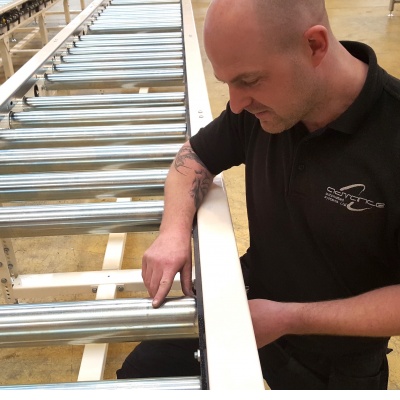A conveyor system can be a significant investment for a lot of businesses so it stands to reason that the maintenance of the conveyor system should be a priority. After all it is much less expensive and disruptive in the long run to invest in maintenance than it is to make large conveyor repairs.
A lot of larger, multi-national businesses have their own in-house maintenance teams to look after capital equipment such as conveyor systems, but what about smaller companies? If you don’t have a maintenance department, or are struggling to get resources to look after your conveyor system then you might find the following useful.
Get a service contract
Most reputable conveyor manufacturers will offer you a service and maintenance contract when you purchase the system. If you do not have the man power or expertise in-house to look after the equipment then it would be worth getting a quote from the manufacturer.

Keep critical spares on site
Speak to your manufacturer and ask them to provide you with a critical spares list. This list should contain the parts that are at the most risk of failing coupled with those that would grind the operation to a halt should they fail. The last thing you want is to lose days or even weeks of production because a certain part has a long lead time.
Consider the spares package as part of your initial investment and get them delivered with the conveyor system and stored away.
Good housekeeping is important
Keep the conveyor and the area around the conveyor nice and tidy, get into a routine of cleaning around the conveyor on a regular basis. Loose debris can get tangled up around a roller, jammed in a belt or jam up a drive over time causing unnecessary wear or even damage to a conveyor.
However, and this is important, do not attempt to clean up while the conveyor system is still running as you can put yourself into a potentially dangerous situation. Plan the housekeeping process so that the conveyors system can be powered down and cleaned properly.
Document everything
Had an issue with the conveyor? Document it. Noticed an odd noise coming from a drive unit? Document it. The more you document and the more detail you keep the easier it will be to diagnose problems and carry out effective preventative maintenance.
Photos and, better yet, videos can paint a thousand words so take as much detail as you possibly can on any potential problems so that your maintenance engineers, either your own guys or contractors, have somewhere to start when they begin looking at your conveyor system.
Inspect regularly
Tying in with the point above about documenting everything, inspect your conveyor system regularly. Once a month or once every couple of weeks walk the line and do a quick visual and audio check. Is there anything missing? Does anything look loose? Can you hear anything you shouldn’t be hearing? Document all of your findings so you can share it with your maintenance team.
If you have a lot of sensors on the system, say for example you have a ZLP roller conveyor, then it would be wise to regularly inspect them to ensure they are still aligned with their reflectors and haven't been knocked or tampered with.
If you have people working on the conveyors, perhaps you are using it as an assembly line, speak to the operators. They will know their section of conveyor like the back of their hand, they spend all day with it. You may be surprised at the issues they have but have never thought to report.
Avoid conveyor misuse
Make sure anyone using the conveyor has been trained on how to safely use the equipment.
Take extra care to not overload the conveyor as this will lead to increased wear and stress on things like your drive, belts, chains etc. If you asked for the conveyor to be manufactured to take 25kg/metre then ensure you are not loading up with 50kg/metre for instance.
Seek Expert Advice
If you would like to discuss the maintenance and servicing of your conveyor systems, whether Advance manufactured them or not, then get in touch today.
Published: 26th June 2018
